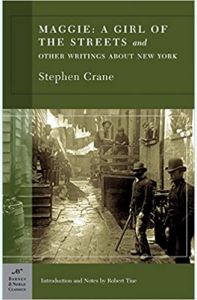The Barnes & Noble Classics series offers quality editions of important works of literature at affordable prices to the student and the general reader, each featuring new scholarship and pages of carefully crafted extras. All editions are beautifully designed and are printed to superior specifications; some include illustrations of historical interest. The series pulls together a constellation of influences; biographical, historical and literary, to enrich each reader's understanding of these enduring works.
Product description
Review
"He was the first American writer because he was the first to be passionately interested in the life that surrounded him and the life that surrounded him was that of America."
From the Inside Flap
This harrowing tale of a young girl in the slums is a searing portrayal of turn-of-the-century New York, and Stephen Crane's most innovative work. Published in 1893, when the author was just twenty-one, it broke new ground with its vivid characters, its brutal naturalism, and its empathic rendering of the lives of the poor. It remains both powerful, severe, and harshly comic (in Alfred Kazin's words) and a masterpiece of modern American prose.
This edition includes Maggie and George's Mother, Crane's other Bowery tales, and the most comprehensive available selection of Crane's New York journalism. All texts in this volume are presented in their definitive versions.
About the Author
Robert Tine is the author of six novels, including State of Grace and Black Market. He has written for a variety of periodicals and magazines—from the New York Times to Newsweek.
Excerpt. © Reprinted by permission. All rights reserved.
From Robert Tine's Introduction toMaggie: A Girl of the Streets and Other Writings about New York
Crane was determined to live in the city and to make his living with his pen. Living a bohemian, hand-to-mouth existence, he took to vanishing into the vast netherworld of the city, living among the whores, the drunks, the drug addicts, and the b'hoys," the Irish gangster swells of the Bowery. Emerging from this underworld, Crane would have enough material for a freelance newspaper piece as well as other material that would becomeMaggie: A Girl of the Streets. Occasional newspaper work, a small but providential inheritance, and regular handouts from one of his brothers allowed Crane to cobble together a modest livingbut it wasMaggie on which he had pinned his hopes.
By 1892 Crane had finished writingMaggie. He approached the editor of Century Magazine, hoping his story would be serialized in the pages of that august publication. Almost immediately his hopes were dashed. The editor found the manuscript cruel" and far too straightforward about the awful details of slum life. At the time there was no shortage of literature about the life of the underclass, but it was always couched in the safe terms of moral disapproval, sugar-coating the misery of the wretched, and suggesting that somehow the poor were responsible for their misery. Crane's matter-of-fact presentation of life in the gutter was, the editor of theCentury felt, too harsh for its middle- and upper-class readership.
Crane then began that dispiriting trek, so well known to first-time novelists, traveling from publisher to publisher only to have his manuscript rejected again and again. Many of the editors who readMaggie had the same opinion: While there was much to admire in the book, the squalor of the story, the appalling degradation of virtually all the characters, and the coarseness of the language were bound to outrage the Mrs. Grundys" of the world (the fictional Mrs. Grundy, introduced in Thomas Morton's play 1798 Speed the Plow, exemplifies the negative influence of conventional wisdom)and bring nothing but opprobrium down on the author and by extension his publisher.
Crane then came up with the idea of publishing his book under a pseudonym, and he chose the bland, almost forgettable name of Johnston Smith." You see," he explained, I was going to wait until the world was pyrotechnic about Johnston Smith's Maggie and then I was going to flop down like a trapeze performer from a wire, coming forward with all the grace of a consumptive hen, and say I am he, friends'" (Stallman,Stephen Crane, p. 69; see For Further Reading").
That Crane set outto épater les bourgeoisoutrage the middle classthere can be little doubt. However, the intentionally scandalous nature of the book still left him with the problem of finding a publishera problem that seemed insurmountable. Following rejection after rejection, Crane was forced to suffer the ignominy of publishing the work himself, paying a house best known for medical texts and religious tracts to print the first edition ofMaggie. In 1893 he paid $869 for 1,100 copies of a cheap-looking yellow paperback edition of the book. Johnston Smith, however, had ceased to existStephen Crane's name appears on the title page. The publisher's name appears nowhere. Even under the canopy of anonymity the publisher had insisted that the manuscript be bowdlerized to a degree. Some of the rougher language and more violent scenes were removed or toned down. ButMaggie: A Girl of the Streets was still pretty strong meat for its day, and Crane now waited (one senses with a degree of gleeful anticipation) for the hue and cry, the fierce literary arguments, the denunciations from the pulpits of every denomination, that would propel Maggie to best-sellerdom and make the young man's fortune.
Instead, silence. No newsstands or reputable bookshop would take the book on account of its incendiary naturethe only exception was Brentano's, which took a dozen copies on consignment and returned ten. In desperation Crane took to giving away copies, dozens and dozens of them, and somehow, miraculously, the book found its way into the literary bloodstream, moving from one man of letters to another. When Crane's spirits and fortunes were at their lowest ebb, he heard through a friend that his book had found its way into the hands of the well-respected author and critic William Dean Howells, who admired the book and announced that he would review it. The friend who gave Crane this welcome news was Curtis Brown, who would later become a prominent literary agent.
Brown remembers: If Crane had been told that Howells had condemned the book he might have heaved a sigh. But instead, given the welcome news, he seemed dazed. He looked around like a man who did not know where he was. He gulped something down his throat, grinned like a woman in hysterics and then went off to take up his vocation again" (Stallman, p. 71).
But even with the enthusiastic support of the powerful Howells, the 1893 edition ofMaggie could only be considered a failure. Just the same, the praise of a literary man whose opinion Crane respected seem to strengthen him and was enough, it seems, to make him take up his vocation again."
This vocation led him to write his finest and best-known work, a novel that became an American classic: The Red Badge of Courage. Published in 1895 by the eminently respectable publishing house of Appleton and Company, the novel achieved huge sales and vast acclaim from the critics and reading public. Stephen Crane was suddenly thrust into the limelight he had sought, and had become, overnight, a literary figure to be reckoned with. He was also a rich young author, a guaranteed best-seller. As a result Maggie: A Girl of the Streets was reissued in 1896, and this time the manuscript was returned to its original stateall of the emendations and coy ellipses were removed.Red Badge of Courage may have made Crane's reputation, but Maggie was first in his heart.
Product details
- Publisher : Barnes & Noble (1 Nov. 2005)
- Language : English
- Paperback : 272 pages
- ISBN-10 : 1593082487
- ISBN-13 : 978-1593082482
- Dimensions : 13.18 x 1.73 x 20.32 cm



































